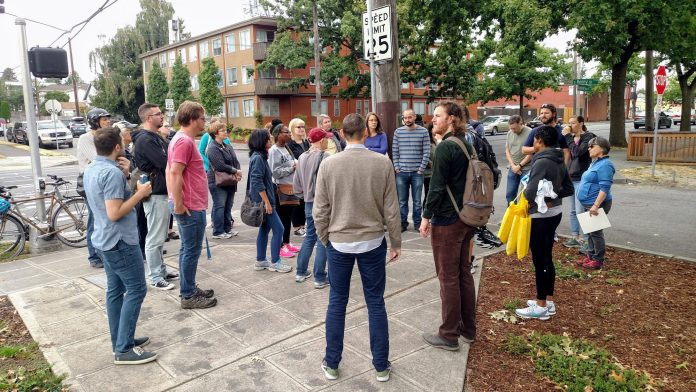On Saturday morning, The Urbanist was pleased to be joined by Seattle Department of Transportation (SDOT) and dozens of advocates for a walking tour of Rainier Avenue S from Hillman City to Mount Baker. SDOT’s Vision Zero Coordinator Jim Curtin described what the agency learned from its rechannelization pilot project in Columbia City and what it had planned for Phase 2 of the Rainier Avenue road diet.
Hillman City
Our tour started outside Firehouse No. 28 in Hillman City, which is at the border of where the road diet pilot project ended. Phase 2 will extend the four lane to three lane rechannelization from Columbia City south to Rainier Beach. We walked north to Tin Umbrella Coffee where a pocket park was a recent improvement to the streetscape. To help the tour visualize what a protected bike lane would be like, Curtin stepped into the street (with cars whizzing by) to show the new lane dimensions.
We discussed the two options still in the running for Phase 2. Option 1 would provide a northbound business access and transit (BAT) lane allowing a significant boost to transit speeds for the Route 7, according to SDOT modeling. Option 2 would provide protected bike lanes, though using bus islands and in lane stops would still upgrade transit operations. Both options would be great for transit, Curtin said.
For Rainier Ave S Phase 2, here's the options that SDOT is looking at. What do you think? pic.twitter.com/lVhXVFIUKE
— The Urbanist (@UrbanistOrg) September 9, 2017
Slowing Speeds
Our next stop was at the intersection with 42nd Ave S. Susan Davis, Executive Director of the Rainier Chamber of Commerce, stood outside her organization’s building and pointed out a concrete planter still bearing a scar from an errant motorist, the planter saved the front door from being demolished, Davis said. That buildings are at risk of motorists channeling their inner battering ram hints at how bad things had gotten on Rainier Avenue before SDOT began these safety reforms. On Seattle’s most collision prone street, not just flesh and blood is at risk, but also brick and mortar.
Bicycling on Rainier Avenue
In Columbia City’s Theater District we discussed the big potential Rainier Avenue has as a bicycling route. With its flat and direct route, it’s the quickest way downtown and toward Rainier Beach. Cascade Bicycling Club’s Policy Manager Kelsey Mesher discussed a group ride of about 30 cyclists she participated in with SDOT Director Scott Kubly on a Friday morning during Bike Everywhere Month. The ride demonstrated Rainier Avenue could be a great street for cycling, even at peak hours.
Accessible Mount Baker
We hopped on a 7 to get to Mount Baker more quickly. At the site of the pedestrian bridge to the neighborhood’s Link station, we talked Accessible Mount Baker–a big reform that would untie the bow-tie intersection of Rainier Avenue and Martin Luther King Way. The change would seek to channel cars toward MLK Way, which has excess capacity, and away from Rainier Avenue, where street calming measures would be ramped up. Curtin said SDOT’s preferred option would tear down the pedestrian bridge to create a plaza and safe at-grade crossings.
Mount Baker Station
Finally, we concluded at Mount Baker Station where Curtin took final questions and we talked about activating the station area, which has great possibilities for placemaking.
The walking tour was a great opportunity for safe streets advocates to come together and share ideas. Big changes are on the way for Rainier Avenue–from the Phase 2 road diet to Accesseible Mount Baker to RapidRide upgrades for the busy Route 7–and advocates have much to be excited about. SDOT Communication Director Mafara Hobson brought some swag intended to fire up advocates and publicize the Vision Zero mission. Our Vision Zero reporter and Senior Editor Ryan Packer was happy to model the swag, as shown below. We encourage you to join us for a future walking tour. Our next Urbanist walking tour will be in South Lake Union on September 23.
Also, thanks for the very cool #VisionZero swag, @seattledot!
💙🚶♀️🚴🚶🚴♀️🚎🚉🚗💙 pic.twitter.com/A3CQASu7ii— The Urbanist (@UrbanistOrg) September 9, 2017
Doug Trumm is publisher of The Urbanist. An Urbanist writer since 2015, he dreams of pedestrian streets, bus lanes, and a mass-timber building spree to end our housing crisis. He graduated from the Evans School of Public Policy and Governance at the University of Washington in 2019. He lives in Seattle's Fremont neighborhood and loves to explore the city by foot and by bike.



